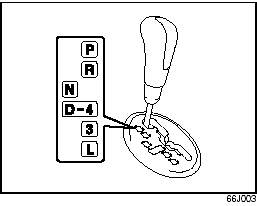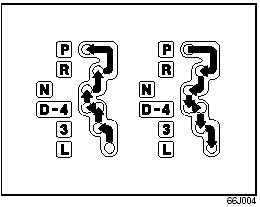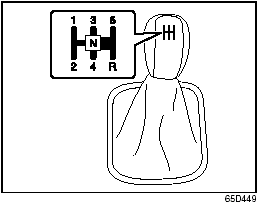Using the Transmission

5-Speed Automatic Transmission
D: 5-speed automatic transmission mode.
4: 4-speed automatic transmission mode.
The 4-speed mode is suitable for the following
driving conditions:
• Driving on hilly, winding roads.
– You can drive more smoothly with less frequent gearshifting.
• Going down a steep hill.
– Some engine braking is provided.
NOTE:
With the transfer switch in the “4L LOCK”
position, the 5-speed automatic transmission
will remain in the 4-speed mode.

Gearshift lever
The gearshift lever is designed so that it can not be shifted out of the “P” position unless the ignition switch is in the “ON” position and the brake pedal is depressed.
 WARNING:
WARNING:
Always depress the brake pedal
before shifting from “P” (Park) (or
“N” (Neutral) if the vehicle is stationary)
to a forward or reverse gear, to
help prevent the vehicle from moving
unexpectedly when you shift.
Use the gearshift lever positions as described below:
P (Park)
Use this position to lock the transmission when the vehicle is parked or when starting the engine. Shift into Park only when the vehicle is completely stopped.
 WARNING:
WARNING:
If you have a 4-wheel drive vehicle,
never leave the transfer switch in “N”
(Neutral) position when parked.
Otherwise the vehicle may roll even if the transmission is in Park.
R (Reverse)
Use this position to back the vehicle from stop. Make sure that the vehicle is completely stopped before shifting into Reverse.
N (Neutral)
Use this position for starting the engine if the engine stalls and you need to restart it while the vehicle is moving. You may also shift into Neutral and depress the brake pedal to hold the vehicle stationary during idling.
D (Drive)
Use this position for all normal driving.
With the selector in “D” range, you can get an automatic downshift by pressing the accelerator pedal. The higher the vehicle speed is, the more you will need to press the accelerator pedal to get a downshift.
4 (Low 3)
Use this position for driving on moderate uphill and downhill gradients. The engine braking effect on moderate downhills can be used in this position. The transmission shifts up only to 4th gear.
3 (Low 2)
Use this position to provide extra power when climbing hills, or to provide engine braking when going down hills.
L (Low 1)
Use this position to provide maximum power when climbing steep hills or driving through deep snow or mud, or to provide maximum engine braking when going down steep hills.
NOTE:
If you move the gearshift lever to a lower
gear while driving faster than the maximum
allowable speed for the lower gear, the
transmission will not actually downshift
until your speed drops below the maximum
speed for the lower gear.
CAUTION:
Be sure to take the following precautions
to help avoid damage to the
automatic transmission:
• Make sure that the vehicle is completely
stopped before shifting into
“P” or “R”.
• Do not shift from “P” or “N” to “R”, “D”, “4”, “3” or “L” when the engine is running above idle speed.
• Do not rev the engine with the transmission in a drive position (“R”, “D”, “4”, “3” or “L”) and the rear wheels not moving.
• Do not use the accelerator to hold the vehicle on a hill. Use the vehicle’s brakes.
Emergency shifting out of “P” (Park)
If you are unable to shift the transmission out of Park in the normal manner, see “If You Can Not Shift Automatic Transmission Gearshift Lever Out Of “P” (PARK)” in the INDEX for what to do.

Manual Transmission
Starting off
To start off, depress the clutch pedal all the way to the floor and shift into 1st gear.
After releasing the parking brake, gradually release the clutch. When you hear a change in the engine’s sound, slowly press the accelerator while continuing to gradually release the clutch.
Shifting
All forward gears are synchronized, which provides for quiet, and easy shifting.
Always push in the clutch pedal fully before shifting gears. Make sure the engine speed does not rise into the red zone of the tachometer.
 WARNING:
WARNING:
• Reduce your speed and downshift
to a lower gear before going down
a long or steep hill. Downshifting
will allow the engine to provide
braking. Avoid riding the brakes or
they may overheat, resulting in
brake failure.
• When driving on slippery roads, be sure to slow down before downshifting.
Large and sudden
changes in engine speed may
cause loss of traction, which could
cause you to lose control.
• Make sure that the vehicle is completely stopped before you shift into reverse.
CAUTION:
• To help avoid clutch damage, do
not use the clutch pedal as a footrest
while driving or use the clutch
to keep the vehicle stationary on a
hill. Depress the clutch fully when
shifting.
• When shifting or starting off, do not race the engine. Racing the engine can shorten engine life and affect smooth shifting.
See also:
Warning and Indicator Lights
Low Tire Pressure Warning Light
As an added safety feature, your vehicle
has been equipped with a tire pressure
monitoring system (TPMS) that uses a low
tire pressure warning light to inform you ...
2WD/i-AWD (intelligent All Wheel Drive) Switch (if equipped)
2WD/i-AWD (intelligent All Wheel Drive) Switch (if equipped)
The 2WD/i-AWD switch is located on the
center console.
For details on how to use the 2WD/i-AWD
switch, refer to “Using the 2WD/i-AW ...
2010 Suzuki SX4 review By Kelsey Mays
Suzuki's SX4 has a sense of urban nimbleness that makes even its sportiest
competitors seem hefty in comparison, but there are a lot of nagging issues
weighing the car down. Some city drivers may ...
